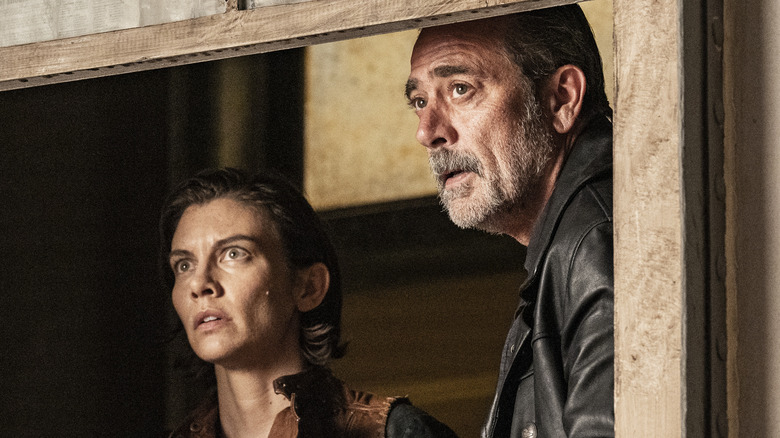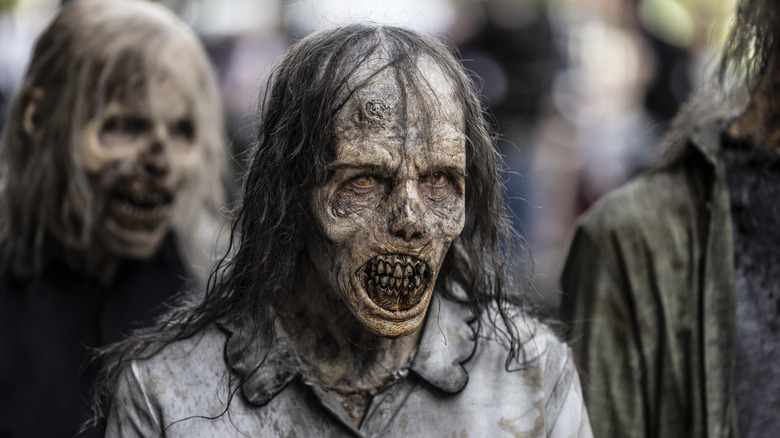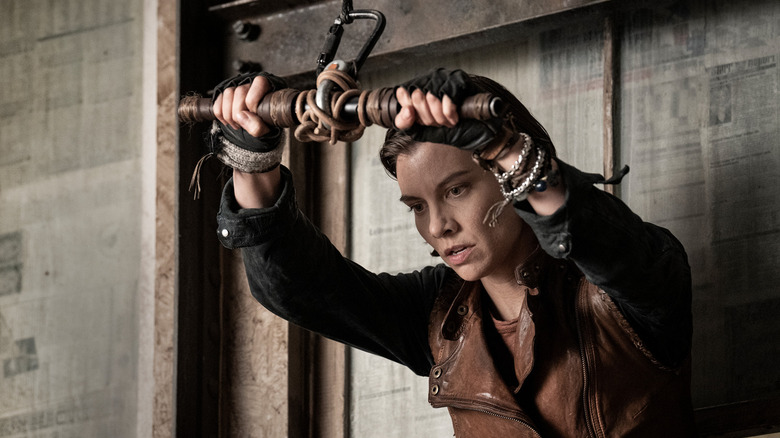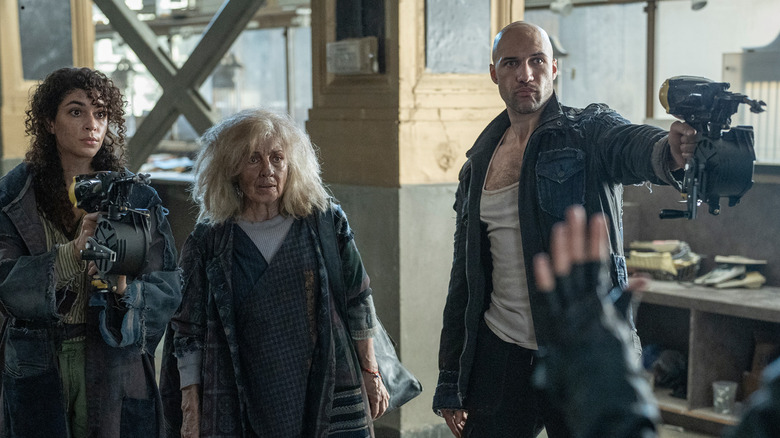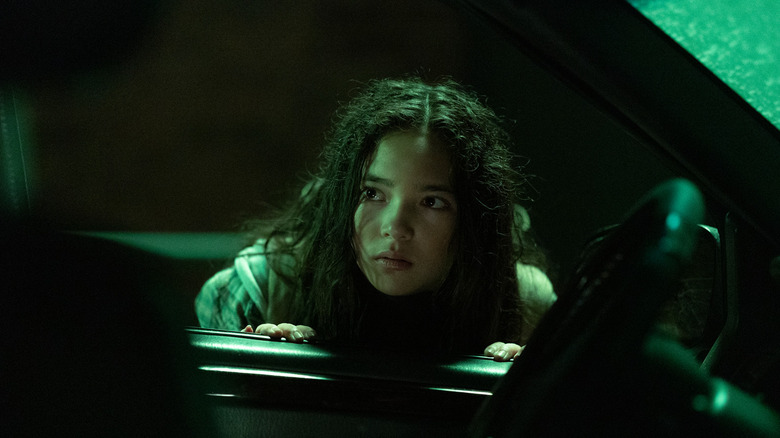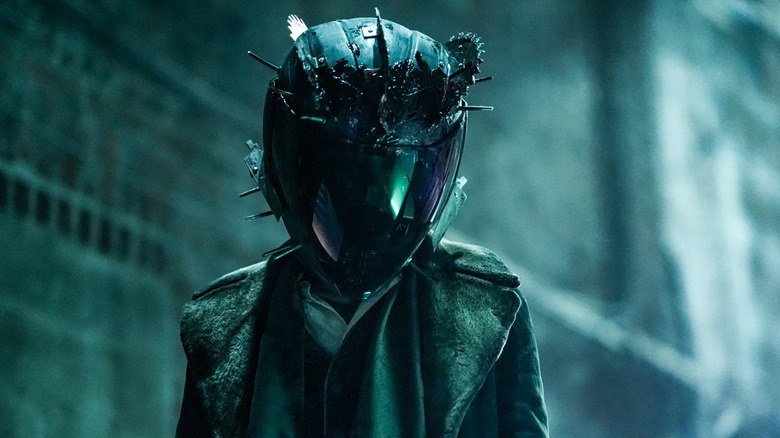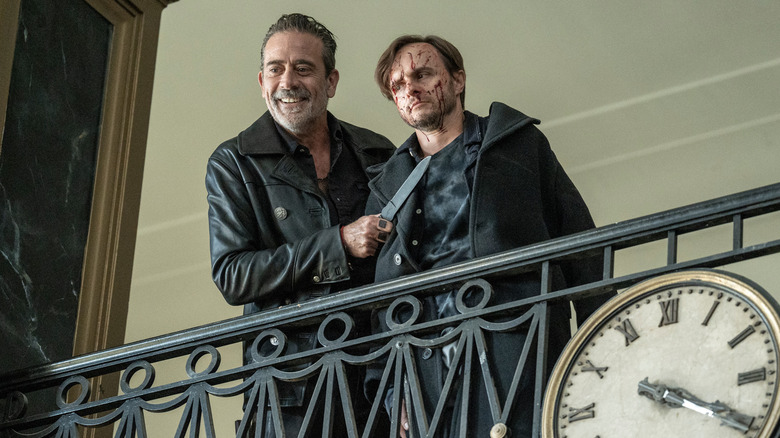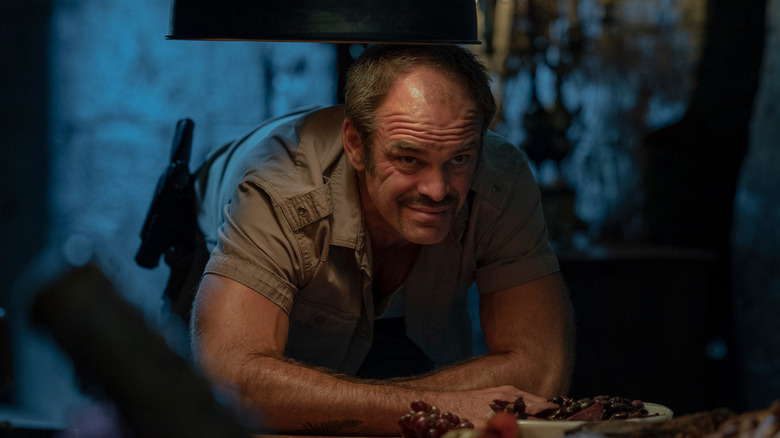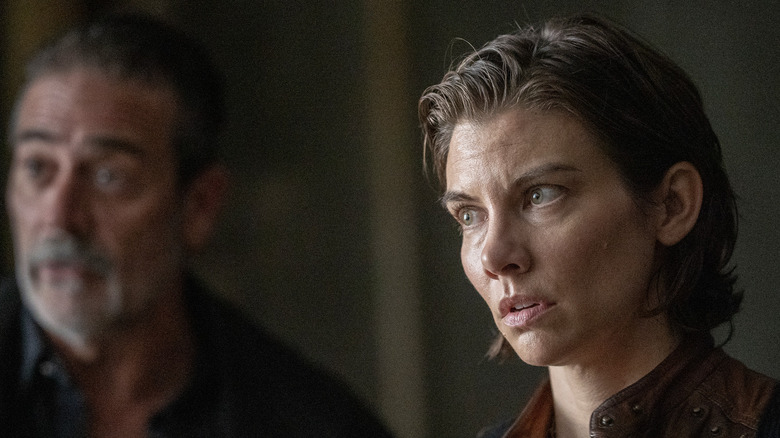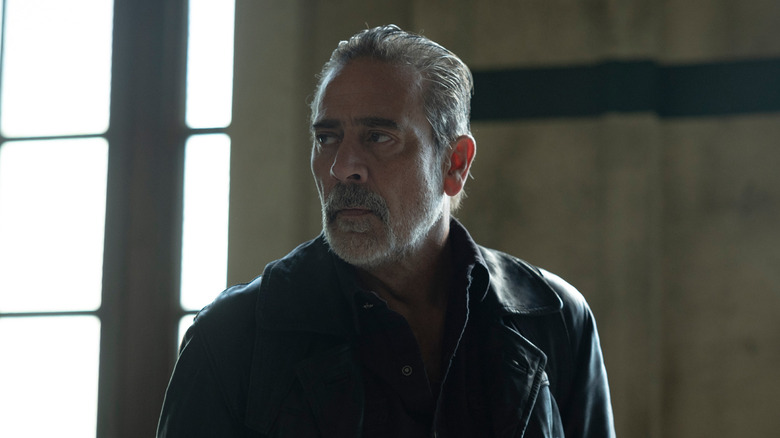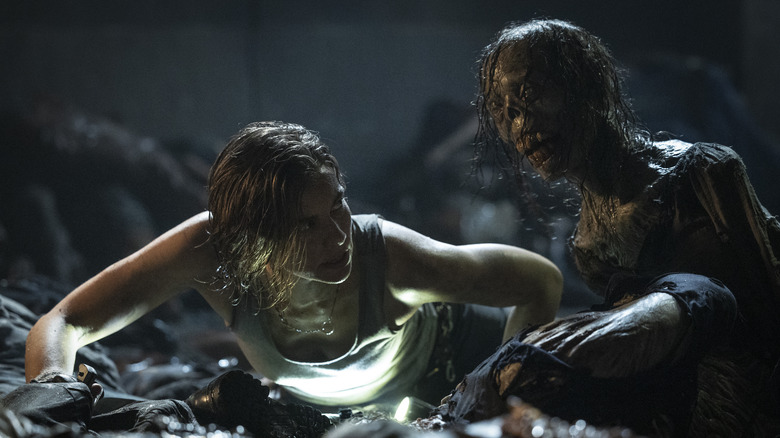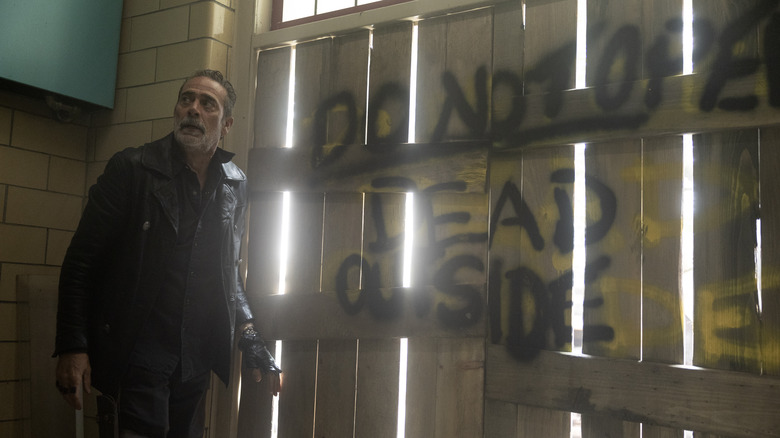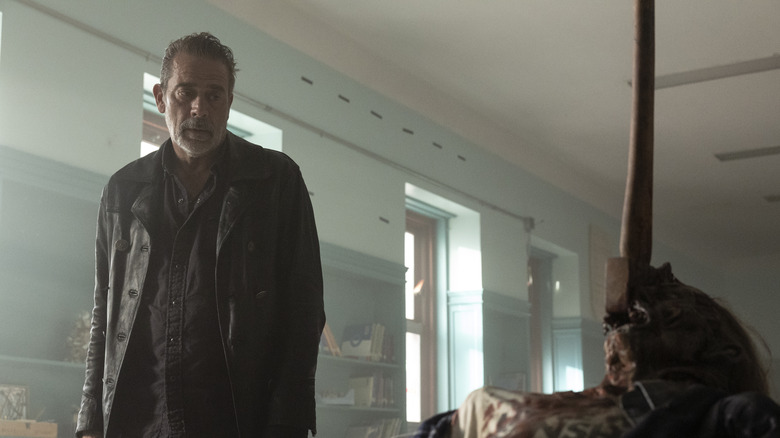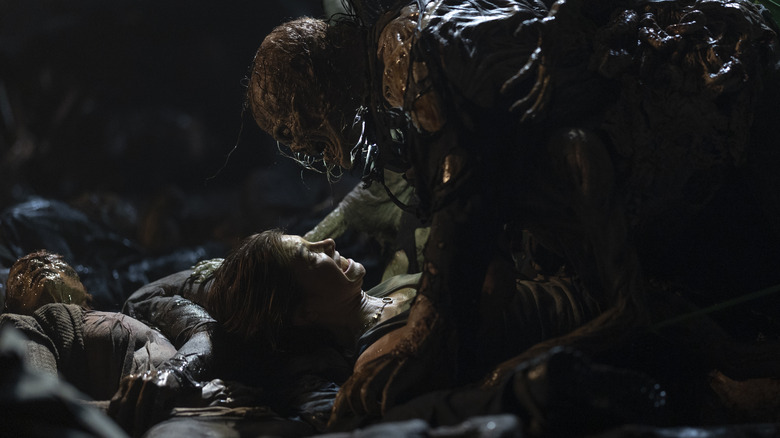Small Details You Missed In The Walking Dead: Dead City
"The Walking Dead" continues to be the franchise that just won't end, as it recently delivered a new spin-off series called "Dead City" that sees two characters with bad blood head to a walker-filled New York City. After her son Hershel (Logan Kim) is kidnapped by a dangerous man called the Croat (Zeljko Ivanek), Maggie (Lauren Cohan) is forced to rely on the help of Negan (Jeffrey Dean Morgan) to save Hershel. However, their journey becomes complicated by the new environment, walkers, and survivors that inhabit the now desolate city. Plus some ulterior motives and past transgressions only add to growing tensions between Maggie and Negan. These two must find a way to put their differences aside to save Hershel and escape with their lives before the Croat sets his sights on them.
"Dead City" might be a new chapter for Maggie and Negan, but it still remembers to deliver some great nods and hidden aspects that tie back to the original series. There are some "blink and you'll miss it" references and callbacks that fans will adore, as well as some smaller meanings stuffed into the background for fans to chew on. "Dead City" is chock full of elements that build out the world and story, while acting as fun nods to the past. Let's delve into some of the small details in "Dead City" that might have even slipped by fans.
Groaners, chompers, and fleshies
While the zombies of "The Walking Dead" have been mostly called "walkers" throughout the franchise's existence, fans know that not everyone refers to them that way. When Rick Grimes (Andrew Lincoln) and his group first arrived in Alexandria, he heard the term "roamers" used to describe walkers and some might remember the police officers from Grady Memorial Hospital using the term "rotters." Other names like empties, geeks, lurkers, and biters have also been used throughout the mainline and spin-off series. But "Dead City" adds three more names to the list — groaners, chompers, and fleshies.
When Maggie first arrives at a bar in her hunt for Negan, she uses the term groaners to describe the walkers shambling around her safe haven, so that she can blend into this new environment. The term chompers is used by the marshal that Maggie and Negan are holding hostage when they arrive in New York City. Lastly, fleshies is the term used by Amaia (Karina Ortiz), Tommaso (Jonathan Higgnbotham), and other survivors in New York City. It's always great to see other names get brought up for the walkers, as it highlights how different parts of the world think and builds out the lore and culture of the "Walking Dead" universe even further.
High-rise subway lines?
With the New York City streets filled with millions of walkers — with some even falling out of the sky — it's completely unsafe to get around by walking through the streets. So survivors have had to come up with new ways to traverse this decaying city. The result is an expansive zipline system that allows people to travel above all the walkers below. We see this system utilized by someone trying to escape the Croat at the end of the first episode, and by Maggie and Negan when they're pursuing Esther (Eleanor Reissa). The system makes sense, since it uses NYC's vast number of tall buildings incredibly well and has created a sort of high-rise subway system for survivors that's fitting for the NYC environment.
Given that the subway is one of the most popular ways of getting around NYC, and that it's become decommissioned in this world because of the methane gas that has spread throughout all the tunnels, it would make sense that New Yorkers would find a way to get a new travel system going. It extends pretty far and ziplines can be seen throughout the city, so it's a system that works well to get around the Walkers — as long as the Croat isn't around to cut the line, of course.
Improvised weapons
As Maggie and Negan first meet Amaia and Tommaso's survivor group, they see that they are holding some bizarre-looking weapons that are actually shown to be grapple guns later in the second episode. While it might seem strange to see these kinds of makeshift weapons be used instead of real guns, it actually makes a lot of sense given the state of the apocalypse by this point. Keep in mind, it's been over a decade at least since the outbreak first occurred and the world was overrun with walkers. Normal guns and ammunition would be tough to come by and the quality of what people would find would also have to be taken into consideration.
Not to mention — as explained early on in the series — the bridges and tunnels that could lead people out of NYC and onto the mainland were destroyed by the government to contain the outbreak. So it's not like people in NYC could just go to other places to find guns. This use of makeshift weapons symbolizes how they've had to adapt in ways that most other survivors haven't. Who knows what other improvised weapons we'll see throughout the series, but they'll surely be in line with how the grapple gun changes the way that survivors, well, survive.
The deeper meaning of the dinosaur
In some brief flashback scenes of Negan and Ginny (Mahina Napoleon) surviving together, we see that Ginny is particularly fond of a stuffed dinosaur that her father supposedly gave her. While this might seem like a simple keepsake for Ginny, this stuffed dinosaur actually holds more meaning for her and the wider themes of this series. In a broad sense, the dinosaur is sort of symbolic of the apocalyptic events that have occurred, as dinosaurs were made extinct through a meteor crashing into Earth and humanity risks becoming extinct because of the walkers.
Ginny's desire to keep the dinosaur also symbolizes a running theme of characters in "Dead City" yearning to hold onto the past. Along with Ginny holding onto a lasting token of her father's memory, Negan struggles to let go of the guilt from his villainous past and Maggie is conflicted about moving past what Negan has done to her. Even the Croat is kind of stuck in the past, in terms of how he still talks about Negan and attempts to recreate the sanctuary he saw Negan build. Many characters in this series are stuck in the past in a dangerous way, and Ginny continuing to hold onto this dinosaur is a subtle and simple reminder of that.
A break in the ranks coming?
While the Croat seems to have built an army that's incredibly loyal and shares his twisted sense of survival, there's a moment in the second episode where we wonder if the series is hinting at a possible break in the ranks. When one of the Croat's soldiers grabs Esther as the group is trying to escape, he can be seen whispering and repeating the phrase "Doma smo." This phrase is brought up again in the following episode, when the Croat is rallying his troops and he translates the Croatian phrase as "We are home." It's a motto that the Croat has clearly been using to keep people believing in him, but the use of it in Episode 2 by this soldier doesn't boast the same confidence.
This soldier says the phrase in a more panicked manner — almost like he's trying to justify or make sense of what he's going to do to Esther. There's a sense of doubt within this soldier that's very clear, and it could be the first sign of some people starting to lose faith in the Croat's plan.
Toying with his prey
A big part of Negan's arc in "Dead City" is him breaking down his villain persona, and there's a conversation he has with Maggie that's very revealing. He describes how his theatrics are part of a "show" he puts on to intimidate those that might challenge him or see him as weak — which is something that Maggie gets a different perspective on later in the episode and that fans might have noticed throughout his time with the franchise.
Negan is sort of playful in his brutality, often making jokes or playing games with his victims to add a bizarre, unnerving layer to his power. Back when he first appeared on "The Walking Dead," Negan played "Eeny Meeny Miny Moe" with Rick's group to see whose head he was going to bash in with Lucille. Fans might also remember him joking about guts before killing Spencer (Austin Nichols).
Here, we see him deliver a knock-knock joke to the Croat's soldiers before slicing open the throat of his hostage and dousing them all with his blood. As a villain, Negan is truly sickening. But "Dead City" offers a better insight into his mindset and fans can now pick up a pattern in Negan's behavior that wasn't as clear before.
Foreshadowing a betrayal
Negan talks a lot about the Croat's time at the Sanctuary as Negan's personal torturer, and how things turned sour when the Croat's disturbing methods were used on a child. We actually get to see that big turning point for Negan during a flashback at the start of Episode 4, and it also leads to the return of one of Negan's most infamous Sanctuary members — Simon (Steven Ogg). While this scene takes place long before Simon tries to unseat Negan as leader and betray him, there are hints of that betrayal seen in this opening flashback.
While walking towards the Croat's torture room, Simon tells Negan that people aren't pleased with the Croat and delivers some slight digs at Negan's leadership. Not only does he insist that he doesn't want to say "I told you so" to Negan about the Croat, but he also mentions that a lot of people are unhappy and want to see Negan invest more authority into keeping the Croat in line. It's a moment that foreshadows Simon's eventual betrayal and acts as a small nod to that event that fans will appreciate.
The widow
When talking with Negan at the end of Episode 4, the Croat brings Armstrong (Gaius Charles) out thinking that Negan wants to kill the Marshall who's been hunting him long before they all arrived in NYC. Negan instead wants to get Hershel back for Maggie and when he tells the Croat this, the Croat refers to Maggie as "the widow." Believe it or not, this is actually a reference to something that Negan has called Maggie in the past.
For a long time after killing her husband Glenn (Steven Yeun), Negan often called Maggie "the widow" as a cruel reminder of what he did to her. It only makes sense that the Croat would call her this too, since he's basically trying to become a new version of Negan throughout the series. However, if the Croat ever tries to call Maggie that to her face, he'll likely find out — as Negan did — that she's the wrong person to poke fun at like that.
Got to see Lady Liberty
Early on, when Negan is talking to Maggie about going to Manhattan, he mentions that his father used to travel into the city and gave him a souvenir figure of the Statue of Liberty — promising to take Negan to see the real thing one day. Unfortunately, that never happened. While his wish to see Lady Liberty herself isn't totally fulfilled, there is a moment in Episode 5 that connects back to Negan's story in a small, but funny way. When hiding out with Armstrong in a souvenir shop as walkers shamble by, Negan can be seen playing with some sort of statue in his hands.
That statue is a small Statue of Liberty figurine, which he's sort of admiring as he perhaps thinks about his prior conversation with Maggie and probably even his father. While it might have been incredible to see Negan killing walkers with the real Lady Liberty in the background, this small detail is a fun way for Negan's wish to be acknowledged.
Body parts
As Armstrong and Negan try to escape the growing number of walkers coming after them, they stumble upon a bizarre mural that actually foreshadows something seen later in the episode. It looks like the body parts of dolls and mannequins have been arranged on the mural in a ritualistic way to create some type of David Cronenberg-type body horror creation. It's seriously disturbing and leaves Armstrong and Negan debating if it's the work of some avant-garde artist from before the world fell apart or someone who lost their mind after. While this might just seem like some random stomach-turning imagery to throw in, it's likely meant to foreshadow the mutated walker that Maggie fights at the end of the episode.
Like the mural, the deformed monstrosity — essentially four or so different walkers melted together from the methane gas — has multiple arms and legs. It's likely that the mural was created in reference to it and that the artist was inspired by seeing the horrifying nightmare themselves. If only Maggie had seen the mural first, she might have been more prepared to fight her toughest undead foe yet.
Going all the way back
As Armstrong and Negan continue to escape incoming walkers, they eventually come to a boarded-up exit with a very familiar message on it: "Do Not Open, Dead Outside." Longtime fans will know that this references the pilot of "The Walking Dead," when Rick stumbles upon a similar message after he wakes up in the hospital. But the message Rick saw was a warning to anyone approaching that the dead were "inside" the room just beyond the door, while Negan's message is referring to walkers being outside the building. Despite changing one word, it's clear that this moment is delivering a great callback to an iconic moment in the original series.
Luckily for Negan and Armstrong, there doesn't end up being any walkers outside, as Armstrong uses the grapple gun to bust open the door so that the two of them can walk out safely. Sadly, that wasn't the case for Rick.
A meaningful number
As Negan continues to help Armstrong to safety, they hide out on a bus with the number "101" on it. While this might seem like nothing important, it could actually be a reference to the comics. Issue #101 of "The Walking Dead" takes place after the notorious sequence in which Negan kills Glenn with Lucille — solidifying himself as the franchise's most vicious and gruesome villain. It's here where the characters are seen reeling from Negan's actions and Maggie's arc in the series takes a drastic turn.
Given that this series is all about Maggie and Negan continuing to work through their conflicts from that fateful day, it's fair to speculate that the number 101 being placed in the background could be referencing the issue that saw Maggie establishing her hate towards Negan. Since "Dead City" also sees Negan coming to terms with the guilt he feels from his villainous actions, this number literally looming over him could be an interesting way to connect Maggie's grief with Negan's guilt.
No head untouched
The big fight sequence at the end of Episode 5 between Maggie and the mutated walker is easily one of the most tense moments of the series, and it features an interesting detail about how to actually kill this monster. Because the creature is basically multiple walkers melted together into one horrifying mess, it features a lot of limbs and heads that make it powerful and dangerous. However, despite it moving as one being, the mutated walker isn't all controlled by one head — meaning that all of its heads need to be stabbed in order to kill it.
Maggie does exactly that and it's actually a fascinating aspect of this disgusting creature. Most creatures like the mutated walker found in other horror and sci-fi stories are normally controlled by a sole brain that needs to be destroyed to defeat the entire thing. However, that isn't the case here. It not only makes sense because of how the creature came to be, but it also adds a cool little detail to its lore and how Maggie has to go about killing it.
